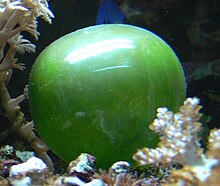Valonia ventricosa
| Valonia ventricosa | |
|---|---|
 |
|
| Scientific classification | |
| Kingdom: | Viridiplantae |
| Phylum: | Chlorophyta |
| Class: | Ulvophyceae |
| Order: | Cladophorales |
| Family: | Valoniaceae |
| Genus: | Valonia |
| Species: | V. ventricosa |
| Binomial name | |
|
Valonia ventricosa J.Agardh 1887 |
|
| Synonyms | |
|
Ventricaria ventricosa |
|
Ventricaria ventricosa
Valonia ventricosa, also known as "bubble algae" and "sailors' eyeballs", is a species of algae found in oceans throughout the world in tropical and subtropical regions. It is one of the largest single-cell organisms.
Valonia ventricosa typically grow individually, but in rare cases they can grow in groups.
They appear in tidal zones of tropical and subtropical areas, like the Caribbean, north through Florida, south to Brazil, and in the Indo-Pacific. Overall, they inhabit virtually every ocean throughout the world, often living in coral rubble. The greatest depth for viability has been seen as approximately 80 metres (260 ft).
The single-cell organism has forms ranging from spherical to ovoid, and the color varies from grass green to dark green, although in water they may appear to be silver, teal, or even blackish. This is determined by the quantity of chloroplasts of the specimen. The surface of the cell shines like glass. The thallus consists of a thin-walled, tough, multinucleate cell with a diameter that ranges typically from 1 to 4 centimetres (0.4 to 1.6 in) although it may achieve a diameter of up to 5.1 centimetres (2.0 in) in rarer cases. The "bubble" alga is attached by rhizoids to the substrate fibers.
Reproduction occurs by segregative cell division, where the multinucleate mother cell makes daughter cells, and individual rhizoids form new bubbles, which become separate from the mother cell.
Valonia ventricosa has been studied particularly because the cells are so unusually large that they provided a convenient subject for studying the transfer of water and water-soluble molecules across biological membranes. It was concluded that the properties of permeability in both osmosis and diffusion were identical, and that urea and formaldehyde molecules did not require any kind of postulated water-filled pores in the membrane to move through it. In studying the cellulose lattice, and its orientation in biological structures, Valonia ventricosa has undergone extensive X-ray analytical procedures. It has also been studied for its electrical properties, due to its unusually high electrical potential relative to the seawater that surrounds it.
...
Wikipedia
